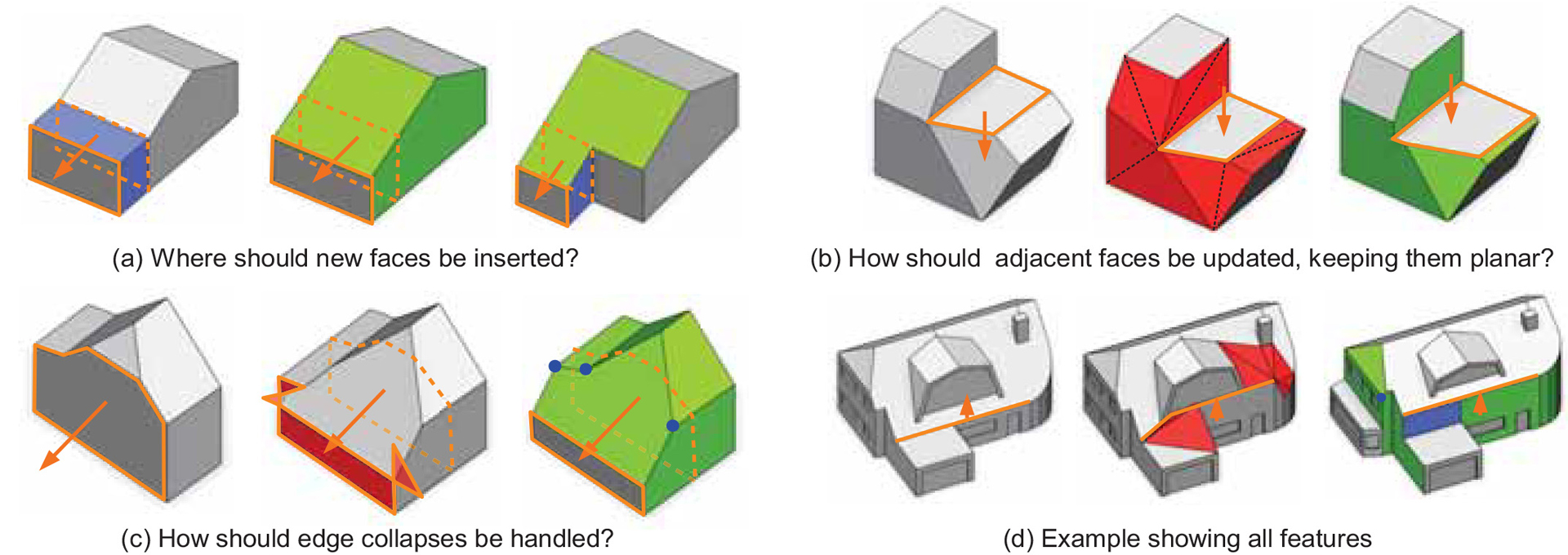“PushPull++” by Lipp, Wonka and Müller
Conference:
Type(s):
Title:
- PushPull++
Session/Category Title: Interactive Modeling
Presenter(s)/Author(s):
Moderator(s):
Abstract:
PushPull tools are implemented in most commercial 3D modeling suites. Their purpose is to intuitively transform a face, edge, or vertex, and then to adapt the polygonal mesh locally. However, previous approaches have limitations: Some allow adjustments only when adjacent faces are orthogonal; others support slanted surfaces but never create new details. Moreover, self-intersections and edge-collapses during editing are either ignored or work only partially for solid geometry. To overcome these limitations, we introduce the PushPull++ tool for rapid polygonal modeling. In our solution, we contribute novel methods for adaptive face insertion, adjacent face updates, edge collapse handling, and an intuitive user interface that automatically proposes useful drag directions. We show that PushPull++ reduces the complexity of common modeling tasks by up to an order of magnitude when compared with existing tools.
References:
1. Autodesk, 2014. Autocad, http://www.autodesk.com/autocad.Google Scholar
2. Autodesk, 2014. Maya, http://www.autodesk.com/maya.Google Scholar
3. Baumgart, B. G. 1974. Geometric modeling for computer vision. PhD thesis, Stanford, CA, USA. Google ScholarDigital Library
4. Bernstein, G., and Wojtan, C. 2013. Putting holes in holey geometry: Topology change for arbitrary surfaces. ACM TOG 32, 4, 34:1–34:12. Google ScholarDigital Library
5. Bokeloh, M., Wand, M., Koltun, V., and Seidel, H.-P. 2011. Pattern-aware shape deformation using sliding dockers. ACM TOG 30, 6, 123:1–123:10. Google ScholarDigital Library
6. Bokeloh, M., Wand, M., Seidel, H.-P., and Koltun, V. 2012. An algebraic model for parameterized shape editing. ACM TOG 31, 4, 78:1–78:10. Google ScholarDigital Library
7. Botsch, M., and Sorkine, O. 2008. On linear variational surface deformation methods. IEEE Trans. on Visualization and Computer Graphics, 1, 213–230. Google ScholarDigital Library
8. Botsch, M., Pauly, M., Kobbelt, L., Alliez, P., Lévy, B., Bischoff, S., and Rössl, C. 2007. Geometric modeling based on polygonal meshes. In ACM SIGGRAPH courses. Google ScholarDigital Library
9. Bouaziz, S., Deuss, M., Schwartzburg, Y., T. Weise, T., and Pauly, M. 2012. Shape-up: Shaping discrete geometry with projections. Comp. Graph. Forum 31, 5, 1657–1667. Google ScholarDigital Library
10. Cabral, M., Lefebvre, S., Dachsbacher, C., and Drettakis, G. 2009. Structure preserving reshape for textured architectural scenes. Comp. Graph. Forum 28, 469–480.Google ScholarCross Ref
11. Deng, B., Bouaziz, S., Deuss, M., Zhang, J., Schwartzburg, Y., and Pauly, M. 2013. Exploring local modifications for constrained meshes. Comp. Graph. Forum 32, 2, 11–20.Google ScholarCross Ref
12. Foley, J. 1996. Computer graphics: principles and practice. Addison-Wesley Professional. Google ScholarDigital Library
13. Gal, R., Sorkine, O., Mitra, N., and Cohen-Or, D. 2009. iWIRES: An analyze-and-edit approach to shape manipulation. ACM TOG 28, 3, 33:1–33:10. Google ScholarDigital Library
14. Habbecke, M., and Kobbelt, L. 2012. Linear analysis of nonlinear constraints for interactive geometric modeling. In Comp. Graph. Forum, vol. 31, 641–650. Google ScholarDigital Library
15. Havemann, S., and Fellner, D. 2005. Generative mesh modeling. PhD thesis, Technische Universität Braunschweig.Google Scholar
16. Kelly, T., and Wonka, P. 2011. Interactive architectural modeling with procedural extrusions. ACM TOG 30, 2, 14:1–14:15. Google ScholarDigital Library
17. Kobbelt, L., Campagna, S., Vorsatz, J., and Seidel, H. 1998. Interactive multi-resolution modeling on arbitrary meshes. In Proceedings of Computer graphics and interactive techniques, 105–114. Google ScholarDigital Library
18. Kraevoy, V., Sheffer, A., Shamir, A., and Cohen-Or, D. 2008. Non-homogeneous resizing of complex models. ACM TOG 27, 5, 111:1–111:9. Google ScholarDigital Library
19. Kripac, J., 2005. Controlled face dragging in solid models. US Patent 6,867,771.Google Scholar
20. Sasaki, N., Chen, H., Sakamoto, D., and Igarashi, T. 2013. Facetons: face primitives with adaptive bounds for building 3d architectural models in virtual environment. In Proc. of the 19th ACM Sym. on VR Software and Technology, 77–82. Google ScholarDigital Library
21. Schell, B., Esch, J., and Ulmer, J., 2003. System and method for three-dimensional modeling. US Patent 6,628,279.Google Scholar
22. Shapiro, V. 2002. Solid modeling. Handbook of computer aided geometric design 20, 473–518.Google Scholar
23. Trimble, 2013. Sketchup, www.sketchup.com.Google Scholar
24. Vaxman, A. 2012. Modeling polyhedral meshes with affine maps. Comp. Graph. Forum 31, 5, 1647–1656. Google ScholarDigital Library
25. Yang, Y., Yang, Y., Pottmann, H., and Mitra, N. 2011. Shape space exploration of constrained meshes. ACM TOG 30, 6, 124:1–124:12. Google ScholarDigital Library
26. Zeleznik, R., Herndon, K., and Hughes, J. 1996. Sketch: An interface for sketching 3d scenes. In Proc. of SIGGRAPH 96, 163–170. Google ScholarDigital Library
27. Zheng, Y., Fu, H., Cohen-Or, D., Au, O., and Tai, C. 2011. Component-wise controllers for structure-preserving shape manipulation. In Comp. Graph. Forum, vol. 30, 563–572.Google ScholarCross Ref
28. Zorin, D., Schröder, P., and Sweldens, W. 1997. Interactive multiresolution mesh editing. In Proceedings of Computer graphics and interactive techniques, 259–268. Google ScholarDigital Library




